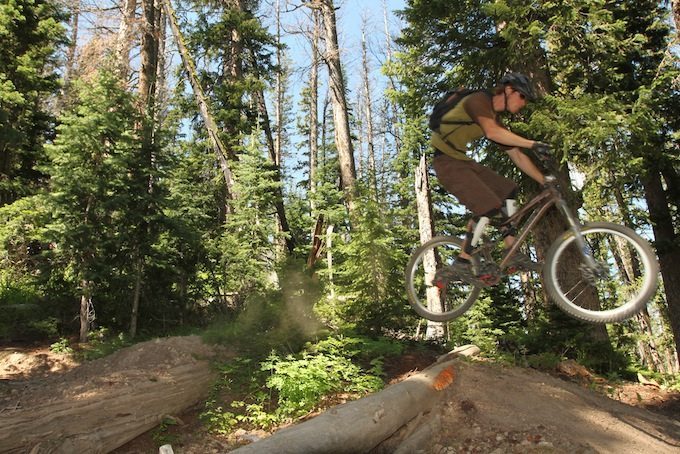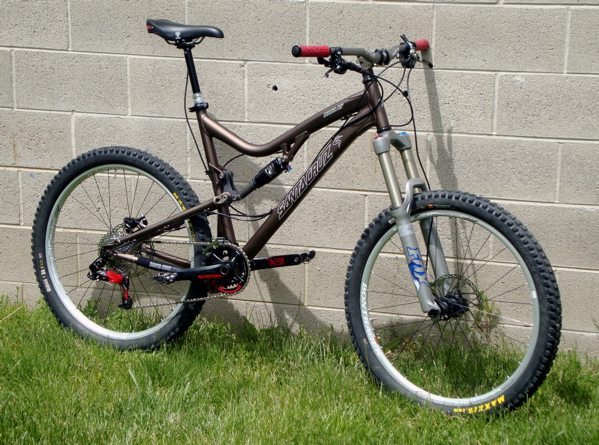[Editor’s Note: Our review, originally published last fall, was conducted on the 2011 X9 drivetrain, a good system that for 2012 is even more customizable. In addition to replacing the bushings in the shifters will ball bearings, SRAM is offering more chainring options and bottom bracket configurations. It’s worth a look.]
Product: 2011 SRAM X9 Drivetrain (Shifters / Cranks / Cassette / Front & Rear Derailleur)
Intended Use: XC / Trail / All-Mtn
Bike: Santa Cruz Blur LT2
Rider: 6’, 160 lbs., riding mountain bikes everywhere for 15 years
Test Locations: General Salt Lake and Park City area, a bit in Jackson
Duration: 50+ days
For 2011, SRAM took the 10-speed technology from its race-proven XX series and spread it through its entire lineup. Ever since I heard how incredible a 2X10 drivetrain feels on a trail bike, it has been on the top of my wish list, and I was stoked to see SRAM make this technology available to those of us on a budget who are looking for high performance.

I have used SRAM’s X9 9-speed shifters and rear derailleur predominantly for the past 5+ years, quite simply, because they work. The system delivers reliable and accurate shifting with very little need for adjustment, while also being plenty tough.
The other bonus is that it costs significantly less than the XO trim, but sacrifices very little in performance and weight. For a broke grad student, this is very appealing! So when it was time to build up my new Santa Cruz LT2 this summer, I did everything I could to fit it with the new X9 parts, and I am very happy I did.

(Side note: Before continuing, I feel I should give my take on Jeff Brine’s 1X10 / X9 article. Honestly, I too would be running 1X10 if I didn’t frequently torture myself with steep and prolonged climbs. I could certainly run 1X10 if I didn’t mind pushing my bike up the steepest sections of the rides I do regularly, but I don’t really like pushing my bike, especially when I know I could ride out the section if I had a lower gear.
As Jeff says in his article, if you spend most of your time in the middle ring of a 3X9 system, you will probably love 1X10. But if you spend a large amount of time grinding up something long and steep to hit your favorite DH runs, 2X10 may suit you better.)
The Promises
So what are the benefits of switching to a 2X10? Well, SRAM’s 2X10 website claims “a full range of usable gears, less weight, and easier and smoother shifting in all terrains,” and I don’t disagree.
Shifting performance has proven to be even better than that of the already fantastic 3X9, 9-speed system. Front ring shifting is reduced by the ability to swing through the entire cassette with ease, no matter which ring the chain is on in front.
As for weight…
| X9 10-speed | X9 9-speed | XO 10-speed | |||
| shifter |
232 |
240 |
232 |
||
| r. derail |
204 |
215 |
190 |
||
| f. derail |
142 |
160 |
130 |
||
| cassette |
350 |
310 |
237 |
||
| cranks |
881 |
N/A |
788 |
||
| chain |
257 |
298 |
255 |
||
Having spent a season pushing a 2X10, I can say that there is something magical about running a 26-39 front ring setup with an 11-36 cassette.
I’m not an engineer. I’m not overly concerned with how something works, I’m more interested in the question, Does it work? And the answer here is a resounding Yes. Without getting all techy and filling up a page with scores of gear ratios, I’ll tell you the simple explanation of how it feels to ride 2X10 versus a 3X9.
First, on steep climbs, I have never once wished for a lower gear. With the larger front rings of the 2X10 gearing, drivetrain drag is significantly reduced, making it feel significantly easier to push similar gear ratios of a 3X9 set up. This translates into more distance traveled with similar output; you can ride faster with the same amount of effort. Bonus!

nice bike you have there, plan to change my SLX to SRAM X9, for my giant reign, thank for the review mate.